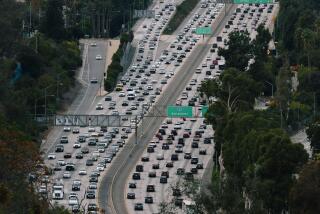New Freeway May Be Traffic Headache of the Century for City Streets : Transportation: High-tech 105 corridor in some ways has created more problems than it solved, especially on north-south routes. Solutions are being explored.
SOUTHEAST AREA — When the Century Freeway (105) opened in the fall, Caltrans officials predicted the 12-lane, super high-tech highway would reduce traffic in the surrounding cities by as much as 25%.
So much for predictions.
Nearly three months later, many once-quiet surface streets are jammed with traffic in the Southeast cities along the 17.3-mile freeway, which runs between El Segundo and Norwalk.
In Downey, scores of cars flood Bellflower Boulevard at rush hour, forcing drivers to wait through up to four cycles of an oh-so-slow traffic light before hitting green. Officials say rush-hour traffic along Bellflower was light before the freeway opened.
In Lynwood, the city’s only freeway exit--Long Beach Boulevard--is becoming increasingly congested, and commuters are clogging tiny residential streets to the south in an effort to escape the crush.
And in Norwalk, where the highway ends at the San Gabriel River Freeway (605), hundreds of motorists opt for nearby surface streets each evening to avoid the huge backups caused by the timed off-ramp signal that lets just three cars through at a time.
The freeway is equipped with the most modern technology--including sensors buried in the pavement to monitor traffic flow, and closed-circuit television cameras to alert officials to accidents. But the roadway has caused some old-fashioned headaches for officials, residents and commuters in surrounding cities.
“People in these poor cities are finally looking around and asking, ‘What has hit us?’ ” said Nancy Luque, who can see, hear and feel the new freeway from her home in Norwalk.
Luque and her neighbors now carefully plan when to pick up their children from piano lessons or sports activities, and they think twice about running to the store before dinner for fear of getting caught in a sea of cars.
They also dread the day in May, 1995, that the Green Line trolley starts running up the middle of the highway and several park-and-ride lots open adjacent to the freeway, increasing surface street congestion even more.
“Our community will never be the same,” said Luque, who in 1984 organized Citizens Against Freeway Fallout to battle Caltrans’ original plan to end the freeway at Studebaker Road, just beyond the 605 Freeway in Norwalk.
Officials at Caltrans said they are not surprised by the higher traffic volumes on the major north-south cross-streets, such as Bellflower, Lakewood and Paramount boulevards. They said they expect traffic to decrease eventually, as drivers adjust to new traffic patterns.
“When you open a major freeway like this, there are always going to be changes in traffic patterns that are basically very hard to predict,” said Larry Loudon, who heads the traffic engineering division at Caltrans. “People are always uncomfortable with change at first, but they will get used to the new flow.”
Loudon pointed out that Caltrans officials correctly predicted lighter traffic on major east-west streets, such as Imperial Highway and Rosecrans Avenue. Commuters who once used those streets are now using the new freeway, he said.
The Century Freeway--so-called because it was once supposed to run along Century Boulevard--can carry up to 175,000 cars per day. The San Diego and Santa Monica freeways--the county’s busiest--each carry more than 325,000 cars daily, Loudon said. The freeway’s name was changed to the Glenn M. Anderson Freeway in 1987 in honor of the retired congressman who helped obtain federal funding for the project.
The roadway connects with four major north-south freeways: the San Diego (405), Harbor (110), Long Beach (710) and San Gabriel River (605). It runs parallel to the Pomona (60) and the Artesia (91) freeways, providing commuters with another east-west route.
Loudon said Caltrans will begin a second series of traffic volume studies on the freeway this month. Initial tests were completed before the $2.2-billion highway opened in October.
The newest study will evaluate access to and from the freeway and determine the need of longer signal cycles or additional traffic lights.
Some cities, however, are not waiting for the study. Last month, the Lynwood City Council, concerned about increased traffic in the residential neighborhoods, decided to spend $30,000 for its own traffic engineering study.
“Caltrans tells us that we should wait six to nine months before re-timing the signals or re-striping lanes because people are still searching for new routes and the traffic patterns have not been established,” City Manager Faustin Gonzales said. “But this is an aggravation to the residents now, and so we want to solve the problems now.”
City officials in Downey said that since the freeway opened, they have received a steady stream of complaints from residents about increased delays along Lakewood Boulevard. The city will begin a traffic study similar to Lynwood’s next month.
“The new freeway has been a mixed blessing,” said Eric Zandvliet, the city’s assistant traffic engineer. “Imperial Highway is a breeze; Lakewood (Boulevard) is the pits.”
Officials in Norwalk--where the freeway off- and on-ramps are not yet finished--said they will wait until later this year to begin studies.
More to Read
Sign up for Essential California
The most important California stories and recommendations in your inbox every morning.
You may occasionally receive promotional content from the Los Angeles Times.










